Pipe Thread Types and Designations
Overview: Different types of screw threads have evolved for fastening,
and hydraulic systems. Of special concern are plastic-to-metal,
taper/parallel threaded joints in hydraulic circuits. A discussion and
recommendations are provided to create an awareness of different types
eads and how they are used.
Over time many different types of screw threads have been developed. Applications
include fastening components, and hydraulic and pneumatic circuits. In the
nineteenth century, manufacturers needing fasteners would devise their own
systems. This resulted in compatibility problems. The English mechanical engineer
and inventor, Sir Joseph Whitworth devised a uniform threading system in 1841 to
deal with these difficulties. The Whitworth thread form is based on a 55 degree
thread angle with rounded roots and crests.
In America, William Sellers set the standard for nuts, bolts, and screws which became
the National Pipe Tapered Thread (NPT) in 1864. His 60 degree thread angle, in
common use by early American clockmakers, enabled the American Industrial
Revolution. These thread forms later became the American National Standard.
The Whitworth thread form was selected as a connecting thread for pipes, which was
made self sealing by cutting at least one of the threads on a taper. This became known
as the British Standard Pipe thread (BSP Taper or BSP Parallel thread). The Whitworth
thread is now used internationally as a standard thread for jointing low carbon steel pipes.
The best known and most widely used connection where the pipe thread provides
both the mechanical joint and the hydraulic seal is the American National Pipe
Tapered Thread, or NPT. NPT has a tapered male and female thread which seals with
Teflon tape or jointing compound.
Pipe threads used in hydraulic cir
cuits can be divided into two types:
a)Jointing threads -are pipe threads for joints made pressure tight by sealing on
the threads and are taper external and parallel or taper internal threads. The
sealing effect is improved by using a jointing compound.
b) Fastening threads ?are pipe threads where pressure tight joints are not made on
the threads. Both threads are parallel and sealing is affected by compression of a
soft material onto the external thread, or a flat gasket.
Sizes
Pipe thread sizes are based on an inside diameter (ID) or flow size. For example, ?/2?4 NPT?identifies a pipe
thread with a nominal inside diameter of 1/2 inch and 14 threads to the inch, made according to the NPT
standard. If is added, the pipe has a left hand thread. The most common global pipe thread forms are:
NPT American Standard Pipe Taper Thread
NPSC American Standard Straight Coupling Pipe Thread
NPTR American Standard Taper Railing Pipe Thread
NPSM American Standard Straight Mechanical Pipe Thread
NPSL American Standard Straight Locknut Pipe Thread
NPTF American Standard Pipe Thread Tapered (Dryseal)
BSPP British Standard Pipe Thread Parallel
BSPT British Standard Pipe Thread Tapered
Plastic injection molded thread forms are manufactured to ANSI B2.1 and SAE J476 standards.
The word apered?in several of the above names points to the big difference between many pipe threads and
those on bolts and screws. Many pipe threads must make not only a mechanical joint but also a leakproof
hydraulic seal. This is accomplished by the tapered thread form of the male matching the thread form of the
female tapered thread and the use of pipe sealant to fill any voids between the two threads which could cause a
spiral leak. The bottoms of the threads aren't on a cylinder, but a cone; they taper. The taper is 1/16 inch in an
inch, which is the same as 3/4 inch in a foot.
Because of the taper, a pipe thread can only screw into a fitting a certain distance before it jams. The standard
specifies this distance as the length of hand tight engagement, the distance the pipe thread can be screwed in by
hand. It also specifies another distance ?the effective thread, this is the length of the thread which makes the seal
on a conventional machined pipe thread. For workers, instead of these distances, it is more convenient to know
how many turns to make by hand and how many with a wrench. A simple rule of thumb for installing tapered
pipe threads, both metal and plastic, is finger tight plus one to two turns with a wrench. Torque installation values
can be determined per application, but due to the variations involved in pipe joints such as disimiliar materials of
male and female threads, type of sealants used, and internal variations in product wall thickness, a standard torque
specification cannot be generically applied .
This table shows the distances and number of turns called for in the standard. A tolerance of plus or minus one
turn is allowed, and in practice threads are often routinely cut shorter than the standard specifies. All dimensions
are in inches.
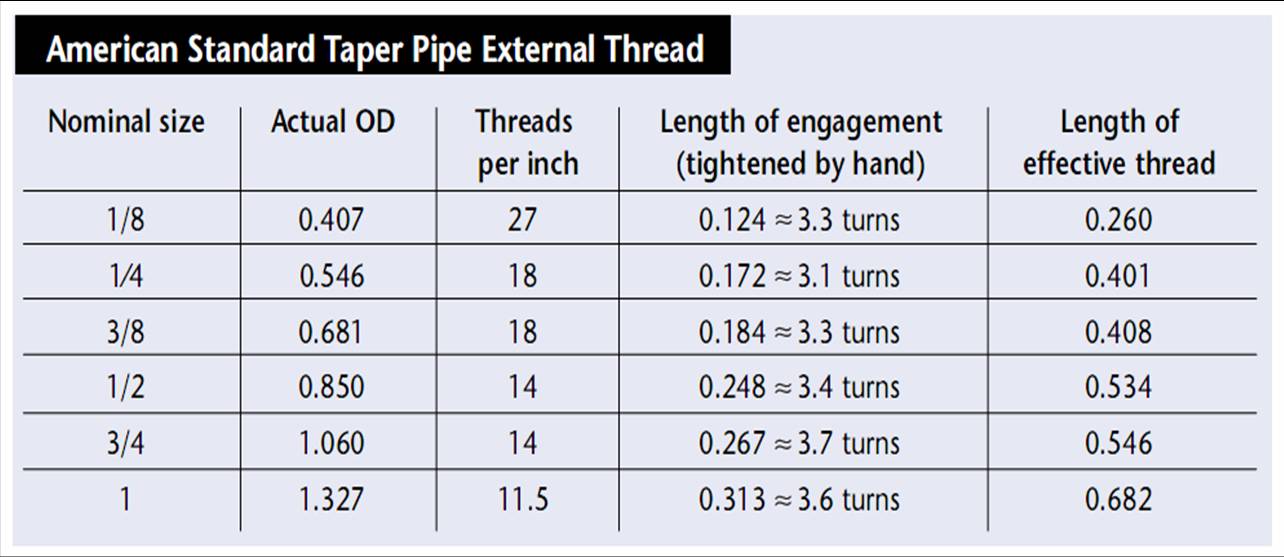
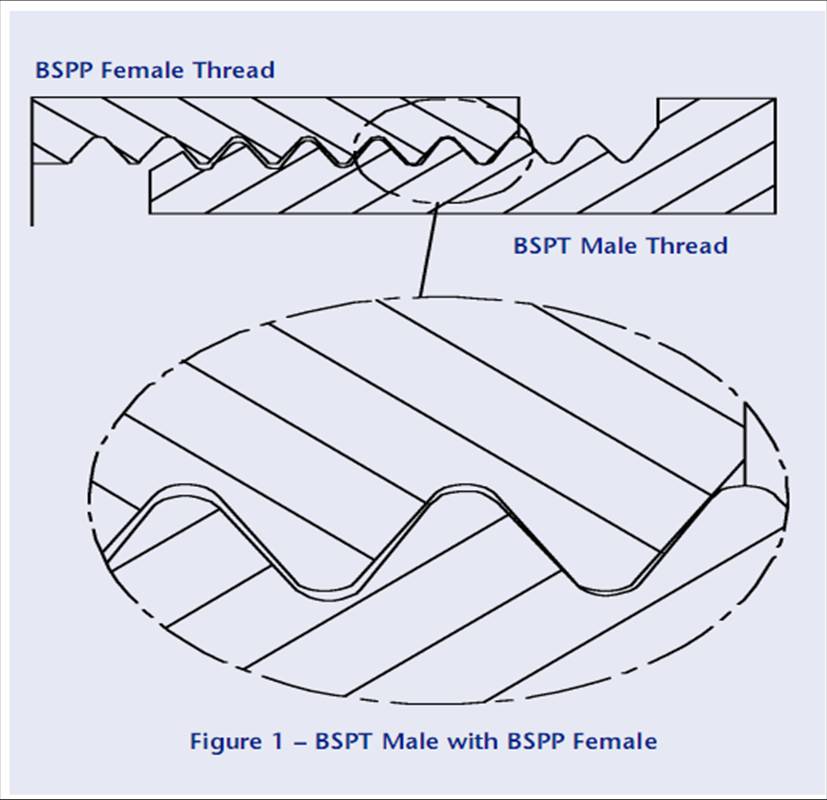
Taper/Parallel Threaded Joints
Despite the standards created to maintain uniform
fittings, tapered pipe threads are inexact and
during the course of use and repair the threads can
become damaged and susceptible to leakage. The
area where the crest and the root of the thread
meet can form a spiral leak path no amount of
tightening will eliminate.
A pressure tight joint is achieved by the compression
in the threads resulting from tightening. This
compression and sealing occurs in the first few turns
of the internal thread. As wrenching takes place,
material from both the male and female threads
deform into each other. This ensures full thread
ariations
contact which minimizes spiral leakages. V
between injection-molded plastic and machined
metal thread forms can occur due to different
manufacturing processes.
Pipe threads were originally designed as machined
thread forms. With the use of thermoplastics and
plastic injection molding in the manufacture of
plastic pipe thread forms, mold shrinkage and
plastic sink make it difficult to insure leak free
joints. For this reason, the use of a Teflon based
sealant is recommended on all plastic pipe threads.
The most common form of sealant is Teflon tape
wrapped 2 to 3 turns around the male thread
before assembly. Liquid Teflon based sealants are
also used successfully to ensure a pressure tight
seal. It is always important to use care when
applying sealants to avoid introducing the sealant
material into the system flow path.
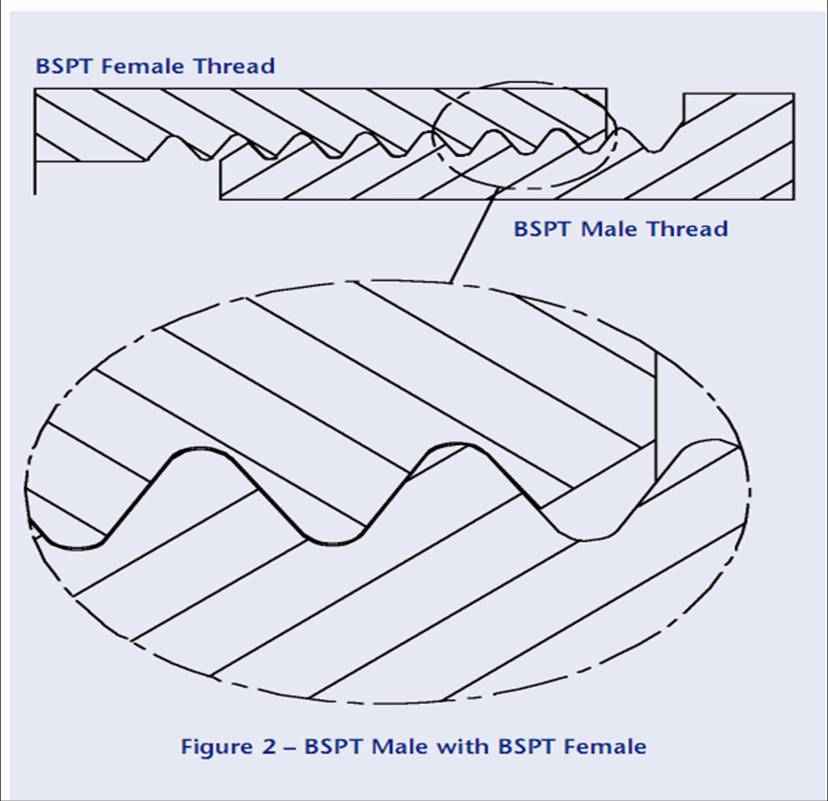
The following sections show examples of how different threads are used and issues that can arise in attempting to create a leak free connection.
When a BSPT tapered male thread is tightened into
a straight female thread (BSPP) the seal can only be
made at the base of the female port with 1 or 2
threads. See figure 1. Sealing is compromised by
the lack of thread form control in BSP specifications.
Variation in crests and roots may cause a mismatch
in the thread and create a spiral leak. Thread sealant
is required to seal this combination.
Using both tapered male and female BSPT threads
would offer a better chance of sealing since you are
now matching the taper of the male and female
thread. See figure 2. This offers more threads a
chance of sealing against spiral leakage. Crest
and root control is still missing, but with thread
sealant, a pressure tight joint would be easier to
accomplish.
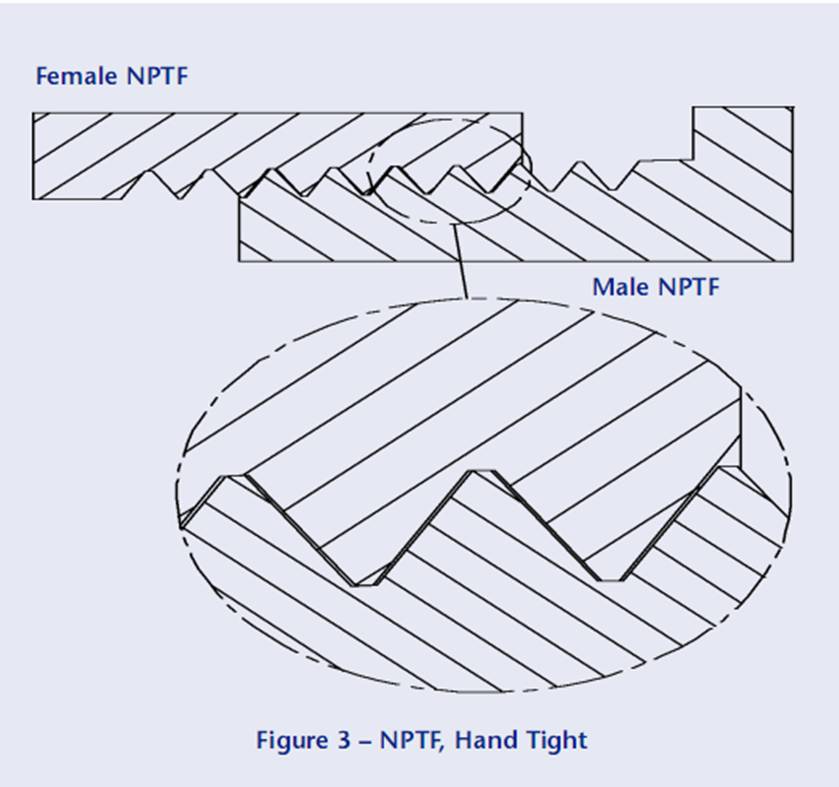
A number of variations of the NPT thread have
been introduced to overcome the problem of
spiral leakage and are known as Dryseal threads
(See SAE standard J476). The best known is the
NPTF (F for Fuel). With this thread design, there
are controls on the crests and roots of both the
male and the female threads to ensure the crest
crushes or displaces material into the root of the
mating thread. The interference fit between the
crest of one thread and the root of the other,
along with the thread flanks matching, seals
against spiral leakage.
Figure 3 shows an NPTF male tightened into
an NPTF female hand tight. You can see the
crests of both the male and female thread come
into contact with the root before the thread
flanks meet.
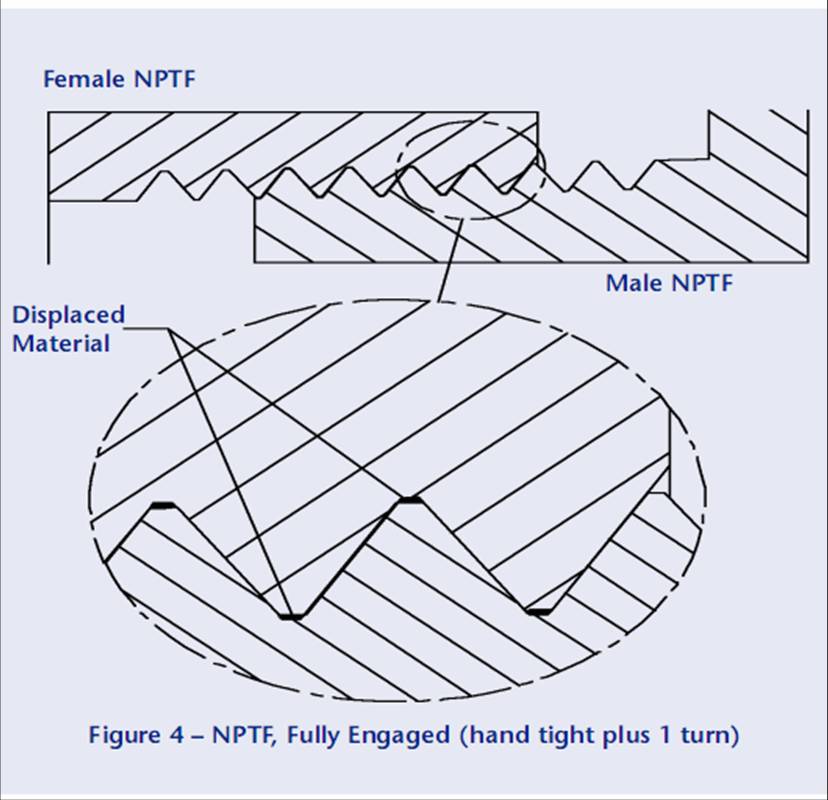
Figure 4 shows the NPTF male and female
threads tightened approximately 1 turn past
hand tight, and you can see the flanks meet and
the crests are displaced into the roots. Although
these threads are considered Dryseal, a Teflon
tape or liquid is still recommended to aid in the
assembly process. The Teflon works as a lubricant
to avoid galling of the material when tightening
the two threads together and also fills any voids
that may cause leakage.
A variation of the Dryseal thread is the NPSF
(National Pipe Straight Fuel). It is used for
internal threads and a NPTF external thread can
be screwed into it to provide a satisfactory
mechanical connection and a hydraulic seal. The
combination of a parallel and tapered thread is
not regarded as ideal but is widely used. High-
quality plastic quick disconnect couplings
typically use NPT threads.
Another tapered thread is the British Standard
Pipe taper, or BSP, covered by British Standard 21.
BSP thread is commonly used for low pressure
plumbing, but is not recommended for medium
and high pressure hydraulic systems. This form
uses the Whitworth thread with an angle of 55?
and a 1 in 16 taper. It is not interchangeable with
the American NPT thread, though at the 1/2" and
3/4" size, they both have 14 threads per inch.
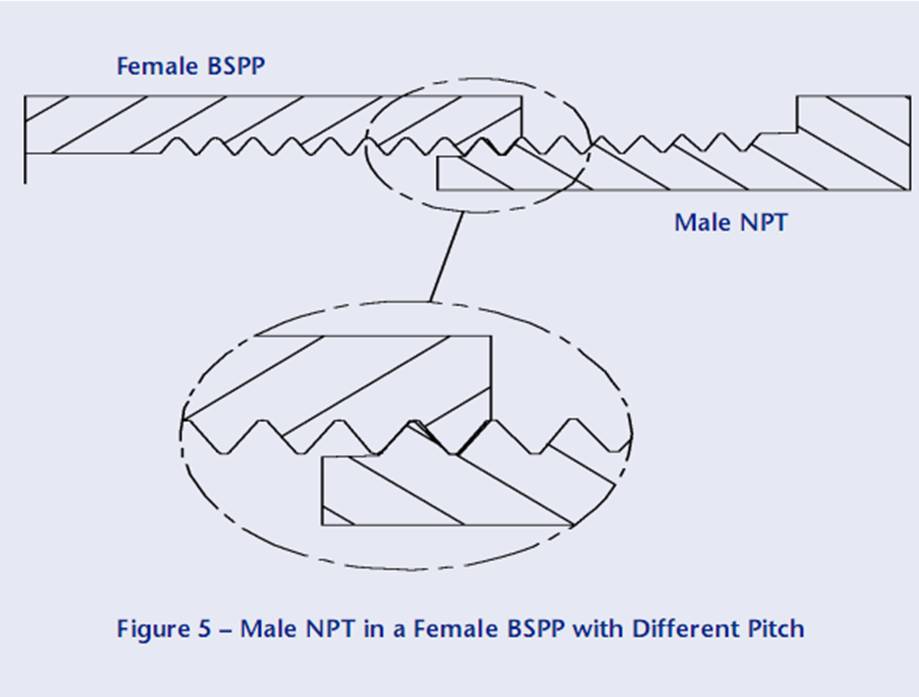
Problems arise when threading a NPT male thread
form into a BSP female straight thread form. The
1/16 inch, 1/8 inch, 1/4 inch, and 3/8 inch sizes have a dissim
pitch, which causes a misalignment of the
threads. The flank angles of the threads are also
different between NPT and BSP. NPT has a 60?
thread where the BSP has a 55?thread.
Figure 5 shows a male NPT tightened into a BSPP.
Because of the smaller size of the BSPP and the
pitch difference, the NPT tightens with only a
few turns.

Figure 6 shows an NPT tightened into a BSPT. The
BSPT being wider at the opening will allow the
NPT thread to engage further, but pitch
difference eventually causes a binding of the
threads. Pitch and thread angle differences will
allow spiral leakage.
The 1/2" and 3/4"sizes in the NPT and BSP e
all 14 threads per inch, and the NPT will engage
the BSP fairly well.
Although these threads are the same pitch and
engage well there are still issures with the thread
form. The thread angles and the crest and root
tolerances being different will allow spiral leakage
as shown in figure 7. These threads might be used
effectively together if an appropriate thread
sealant is incorporated.
Many issues arise when plastic quick disconnect
couplings, with their corresponding injection-
molded pipe thread forms are plumbed into
metal-piped hydraulic systems. Leaks and plastic
thread form failures may occur if care is not taken.
When investigating a metal-to-plastic pipe joint
failure, two factors, chemical attack and over
tightening, need to be considered.
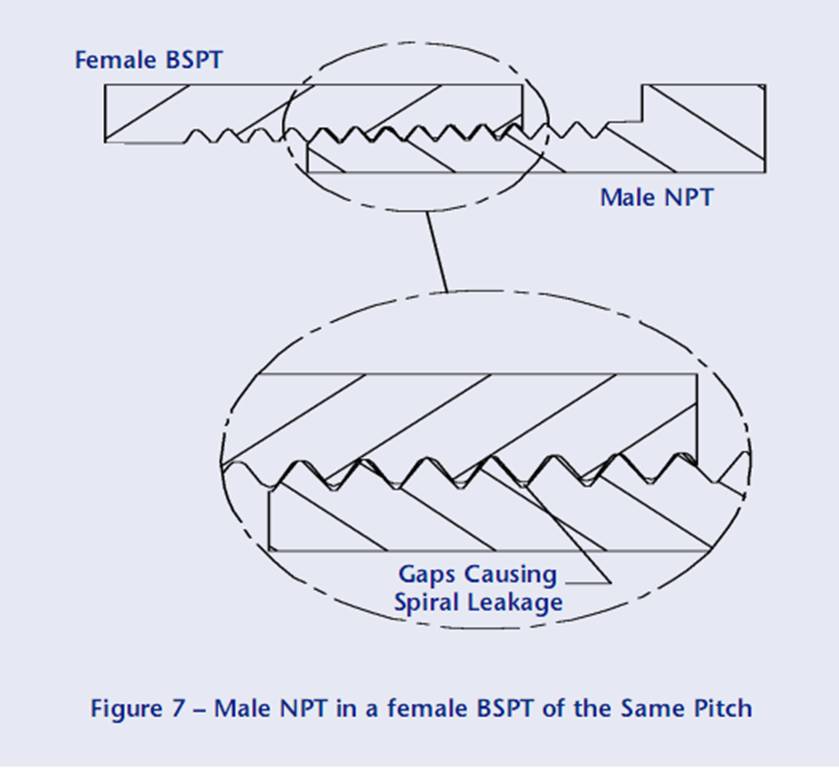
Chemical attack can occur when improper thread
sealants are used. Thread sealing is an attempt to
block the spiral leak path which occurs when the
crests and roots of the thread forms do not match.
Anaerobic thread sealants should be avoided
when sealing plastic thread forms. These sealants
contain chemicals which may attack plastics. Use
of a Teflon-based pipe thread sealant is a better
choice for plastic threads.
Over tightening of any plastic pipe thread will
have adverse affects on the function of the joint.
The major difference between plastics and
metals is the behavior of polymers. Injectionmolded plastic parts continue to deform if they
are held under a constant load e.g. creep. Creep
is the continued extension or deformation of a
plastic part under continuous load. Typically the
plastic material in an injection-molded plastic
pipe thread form will creep from being over
tightened into a female tapered port. The
deformation of the part" internal features ca
lead to part failure.
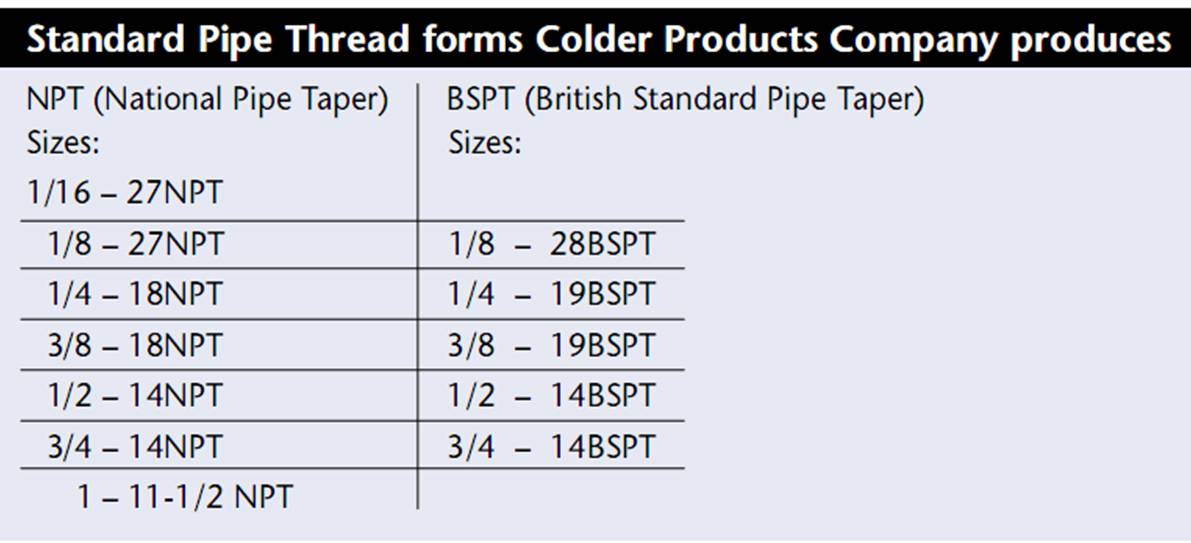
Virtually any thread configuration can be incorporated into a CPC coupler on a custom basis. Some examples of
custom applications are NPSM (National Pipe Straight Mechanical), BSPP (British Standard Pipe Parallel), SAE flare
fittings, and a variety of ISO (Metric) and American Unified screw threads.
With over 20 years experience in the design and manufacture of injection-molded plastic quick disconnect
couplings, Our Company knows about the shrink and sink of molded plastic parts and how they can
affect the seal ability of pipe threads. Our NPT thread has been engineered to add more control to the plastic
thread form to ensure a leak-proof seal. Just give our company email or submit a quote online.
Our team of quote specialists is the most responsive.

